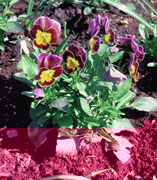


Home
Flowers &
Indoor Plants
Fruits & Nuts
Ornamentals
Vegetables
Special Topics
Resources
Glossary

|
Pansy Viola tricolor (vi-o-lah tri-col-or) |
 |
What about it? Pansies are charming little flowers that are sure to make anyone smile. They are small and delicate plants, with velvet-like flowers in the brightest shades of red, orange, pink, yellow, and purple. Children love their little "faces". What is it used for?Pansies are a wonderful addition to any garden space. There is no spot too small for a bunch of pansies. They are also becoming popular as cut flowers for arrangements. Where do they grow? How do we grow it? Pansies enjoy growing in the cool, early-spring weather. They need cool, moist soil in a partially shaded spot. Plant them 6 inches apart. Add compost to the soil before planting too. Hot summers will do more damage to your pansies than a cold winter. They can survive a winter, providing their spot is well-drained. If temperatures go lower than 15 degrees F, cover your pansies with a protective layer of straw or mulch. Generally, pansies are grown as biennials and are discarded after one spring of bloom. It cannot be said often enough: pick your pansy blossoms daily. The more you pick off the old blossoms, the more new blossoms you will receive. Pansies love attention, and will return the favor. What are its primary problems? Pansies have no significant problems. How do we propagate it? Pansies can be propagated from seed. Sow them in August, and water alot until the seeds sprout. Cover the young plants with straw after the ground has frozen. In the spring they will bloom.
© Copyright, Department of Horticulture, Cornell University. |